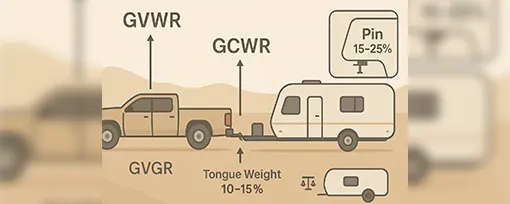Quick glossary (what the ratings mean)
- GVWR – Max allowed weight of a single vehicle fully loaded.
- GCWR – Max combined weight of tow vehicle + trailer when loaded.
- GAWR – Max weight on each axle.
- UVW (dry weight) – Empty weight from the factory.
- GVW/GTW – Actual weight of the vehicle/trailer today.
- Payload rating – What your tow vehicle can carry (people + cargo + tongue/pin weight).
- Tongue/Pin weight – Downforce on the hitch. Travel trailers: 10–15% of loaded trailer weight. 5th wheels: 15–25%.
The three golden rules
- Stay within every rating: GVWR, GAWR, GCWR, and the hitch’s own rating.
- Count tongue/pin weight as vehicle payload—it rides on the tow vehicle.
- Use the loaded trailer weight, not dry weight, when checking tow rating.
Step-by-step: check your setup (example)
- Estimate loaded trailer = UVW + cargo.
- Estimate tongue/pin = loaded trailer × % (TT: 0.10–0.15, 5W: 0.15–0.25).
- Vehicle payload used = passengers & cargo in vehicle + tongue/pin.
- Compare:
- Payload used ≤ payload rating
- Loaded trailer ≤ max tow rating and ≤ trailer GVWR
- (Vehicle curb + passengers + loaded trailer) ≤ GCWR
- Tongue/pin ≤ hitch rating
If any check fails, lighten cargo, adjust tongue weight (move weight forward/back), consider a weight-distribution hitch (travel trailers), or select a lighter trailer/heavier-duty tow vehicle.
Brake controllers—settings that actually matter
- Time-based vs proportional: Proportional controllers use an internal sensor to match brake force to deceleration—smoother and preferred.
- Gain: Start around 6.0–6.5 (varies by rig). On a 20–30 mph stop on level ground, you want firm braking without tire lockup.
- Boost/sensitivity: Add a step of boost for heavier trailers or when starting on grades.
- Manual lever: Test before trips; useful to dampen sway by applying trailer brakes independently.
- Maintenance: Verify trailer grounds, magnet resistance, and breakaway battery health.
Weight-distribution & sway control (travel trailers)
A weight-distribution hitch (WDH) uses spring bars to shift some load back to the tow vehicle’s front axle and onto the trailer axles, restoring steering and braking. Pair it with integrated sway control (dual-cam, 4-point) for best stability. Re-check front-axle height after setup—target close to unhitched height.
Pre-trip quick checklist
- Tire pressures (cold), load range, and date codes.
- Torque lug nuts; inspect bearings/brakes.
- Set brake controller gain and test lever.
- Verify safety chains, breakaway cable, and lighting.
- Confirm tongue/pin %, hitch latch, and WDH tension.
- Distribute cargo low and centered; secure everything.
Includes two tabs (Travel Trailer and 5th Wheel). Enter your ratings and estimates; it flags OK vs EXCEEDS for payload, GCWR, tow rating, hitch rating, and trailer GVWR.
